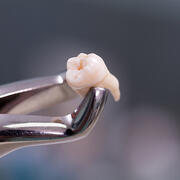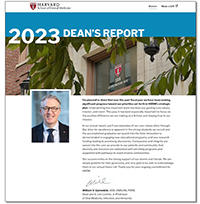
Tooth loss is often accepted as a natural part of aging, but what if there was a way to better identify those most susceptible without the need for a dental exam?
New research led by investigators at Harvard School of Dental Medicine (HSDM) suggests that machine learning tools can help identify those at greatest risk for tooth loss and refer them for further dental assessment in an effort to ensure early interventions to avert or delay the condition.
The study, published June 18 in PLOS ONE, compared five algorithms using a different combination of variables to screen for risk. The results showed those that factored medical characteristics and socioeconomic variables, such as race, education, arthritis, and diabetes, outperformed algorithms that relied on dental clinical indicators alone.
“Our analysis showed that while all machine-learning models can be useful predictors of risk, those that incorporate socioeconomic variables can be especially powerful screening tools to identify those at heightened risk for tooth loss,” said study lead investigator Hawazin Elani, assistant professor of oral health policy and epidemiology at HSDM.
The approach could be used to screen people globally and in a variety of health care settings even by non-dental professionals, she added.
Tooth loss can be physically and psychologically debilitating. It can affect quality of life, well-being, nutrition, and social interactions. The process can be delayed, even prevented, if the earliest signs of dental disease are identified, and the condition treated promptly. Yet, many people with dental disease may not see a dentist until the process has advanced far beyond the point of saving a tooth. This is precisely where screening tools could help identify those at highest risk and refer them for further assessment, the team said.
In the study, the researchers used data comprising nearly 12,000 adults from the National Health and Nutrition Examination Survey to design and test five machine-learning algorithms and assess how well they predicted both complete and incremental tooth loss among adults based on socioeconomic, health, and medical characteristics.
Notably, the algorithms were designed to assess risk without a dental exam. Anyone deemed at high risk for tooth loss, however, would still have to undergo an actual exam, the researchers added.
The results of the analysis point to the importance of socioeconomic factors that shape risk beyond traditional clinical indicators.
“Our findings suggest that the machine-learning algorithm models incorporating socioeconomic characteristics were better at predicting tooth loss than those relying on routine clinical dental indicators alone,” Elani said. “This work highlights the importance of social determinants of health. Knowing the patient’s education level, employment status, and income is just as relevant for predicting tooth loss as assessing their clinical dental status.”
Indeed, it has long been known that low-income and marginalized populations experience a disproportionate share of the burden of tooth loss, likely due to lack of regular access to dental care, among other reasons, the team said.
“As oral health professionals, we know how critical early identification and prompt care are in preventing tooth loss, and these new findings point to an important new tool in achieving that,” said Jane Barrow, associate dean for global and community health and executive director of the Initiative to Integrate Oral Health and Medicine at HSDM. “Dr. Elani and her research team shed new light on how we can most effectively target our prevention efforts and improve quality of life for our patients.”
The research was done in collaboration with researchers at the Harvard T.H. Chan School of Public Health, the University of São Paolo in Brazil, and the University of Otago Faculty of Dentistry in New Zealand.
Co-investigators included André F. M. Batista, W. Murray Thomson, Ichiro Kawachi, and Alexandre D. P. Chiavegatto Filho.
This work was supported by the National Institute on Minority Health And Health Disparities (grant K99MD012253) and CNPq (grant 308731/2018-2).


